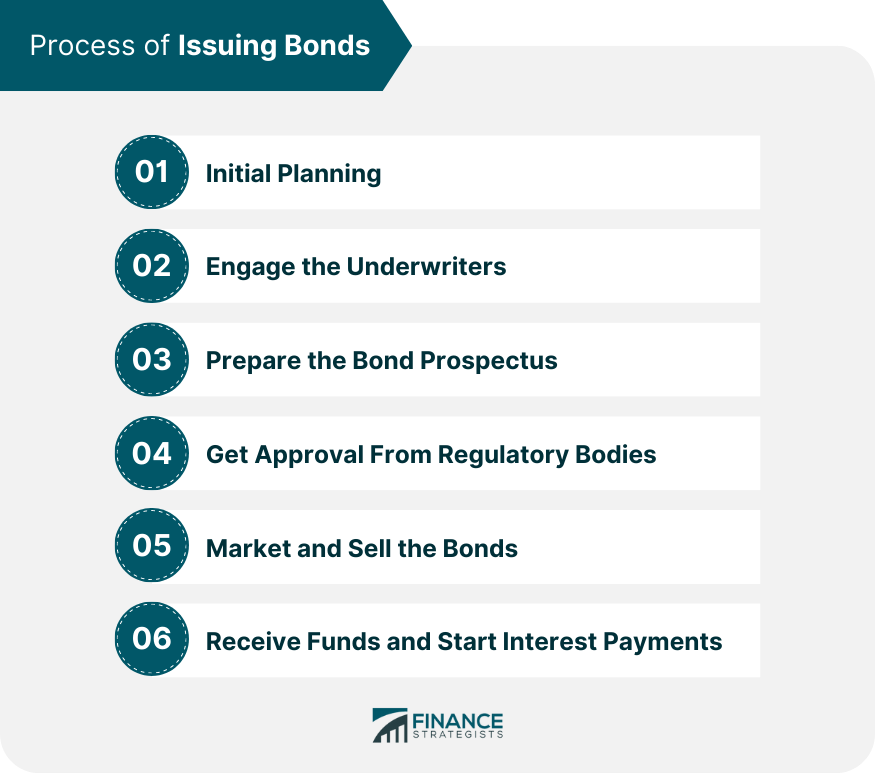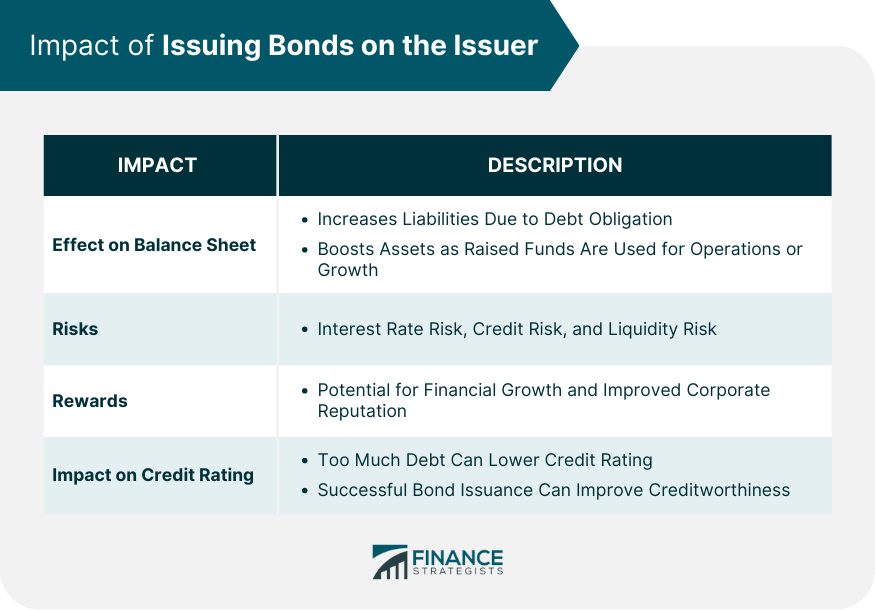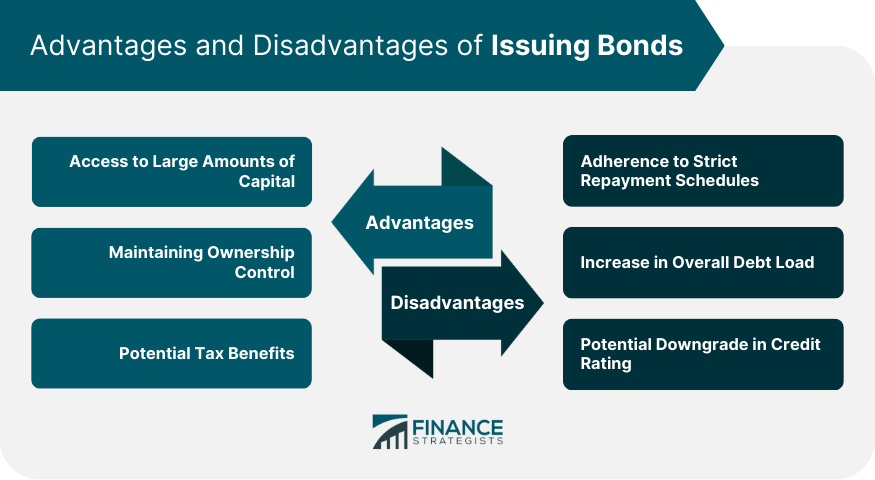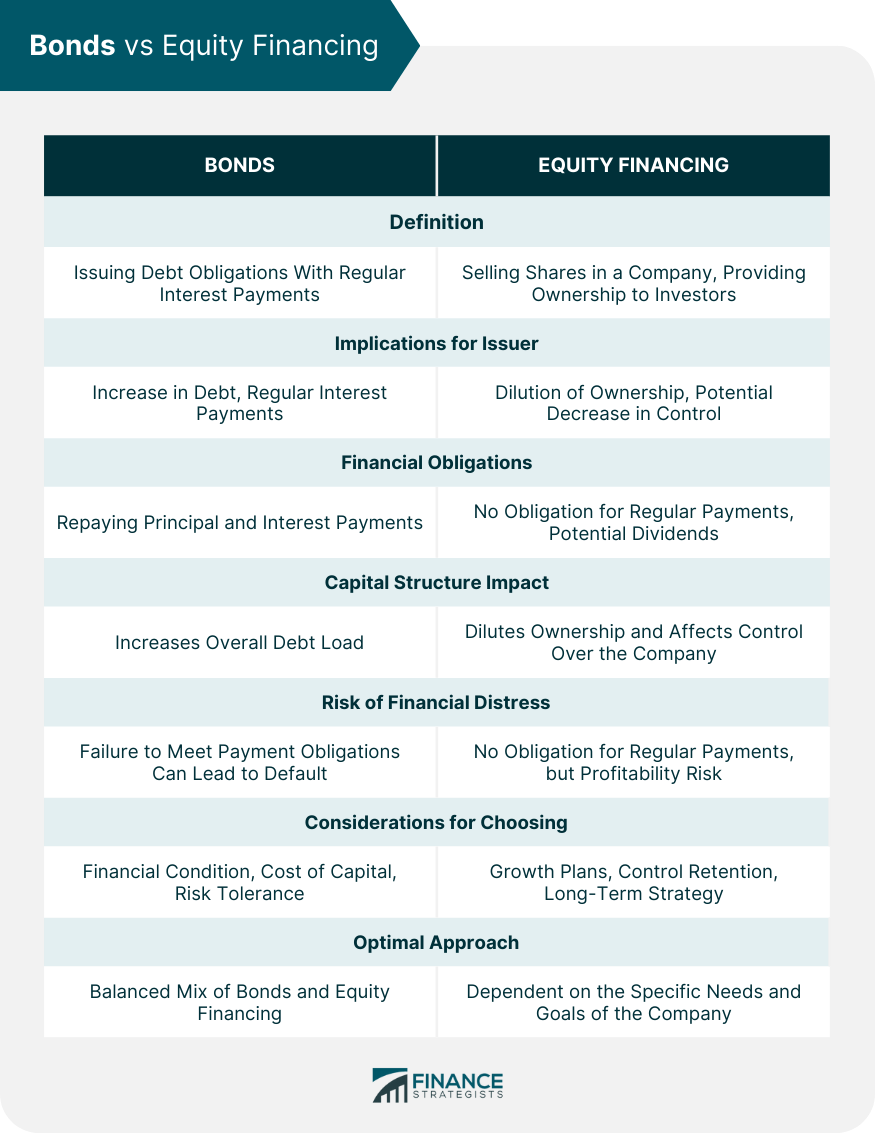A bond is a debt tool used by corporations or governments to raise money. Issuers commit to repay the bond's face value or principal at a set maturity date and make regular interest payments until then. Bonds are crucial in finance, helping entities secure operational or growth capital and providing investors with a reliable income source and principal repayment at maturity, thus diversifying investment portfolios. The first step in issuing bonds is deciding how much money needs to be raised. This depends on the issuer's financial needs and their ability to service the debt. The issuer must ensure they have the financial capacity to meet the periodic interest payments and repay the principal at maturity. The issuer also needs to choose the type of bond to issue. This could be a fixed-rate bond, where the interest rate remains constant throughout the term, or a floating-rate bond, where the interest rate varies according to market conditions. Other types include zero-coupon bonds, convertible bonds, and more. Finally, the issuer must establish the bond's term (how long until the bond matures) and the interest rate, which should be competitive with current market rates for bonds with similar risk profiles. Once the initial planning is done, the issuer engages underwriters, typically investment banks. The underwriters help structure the bond offering, price the bonds, ensure legal compliance, and market the bonds to potential investors. The bond prospectus is a legal document detailing the terms of the bond, the issuer's financial situation, and the potential risks associated with the bond. It's prepared with the help of the underwriters and is essential for investors to make informed decisions. Before the bonds can be sold, the issuer must obtain approval from the relevant regulatory bodies. In the U.S., for example, corporate bond issuances must be registered with the Securities and Exchange Commission (SEC). Once approved, the bonds are marketed to potential investors. The underwriters play a significant role in this process, using their extensive networks to find buyers. This could involve roadshows, presentations, and one-on-one meetings with potential investors. Once the bonds are sold, the issuer receives the funds, and the bonds start accruing interest. The issuer is then obligated to make regular coupon payments to the bondholders and return the principal at maturity. Corporations often issue bonds to raise capital for business expansion, research and development, or to manage existing debt. Governments, on the other hand, issue bonds primarily to fund public projects and services, such as infrastructure development, public schools, and healthcare. While both bonds and loans represent debt obligations, there are significant differences between the two. A loan is a direct agreement between a lender and a borrower, often involving collateral, while a bond is a tradable security sold to multiple investors. Furthermore, loans are usually negotiated directly between the parties involved, while bonds are typically sold on open markets, making them more liquid. The bond issuing process involves several key players. These include the issuer (the entity needing funds), underwriters (usually investment banks that help structure the bond offering and market the bonds), bondholders (investors purchasing the bonds), and regulatory authorities overseeing the process to ensure legal compliance. Bond pricing involves determining the present value of the bond's future cash flows (coupon payments and the principal repayment) discounted at an appropriate interest rate (often referred to as the discount rate). The discount rate is usually based on current market interest rates and the perceived riskiness of the bond. Credit rating agencies, like Moody's, Standard & Poor's, and Fitch, evaluate the issuer's creditworthiness and assign a rating to the bonds. A higher rating signifies lower credit risk, implying the issuer has a strong capacity to meet its financial commitments. Credit ratings directly impact the pricing of bonds. A bond with a higher credit rating can usually be issued with a lower interest rate, as investors perceive it as less risky. Conversely, a bond with a lower credit rating will need to offer a higher interest rate to attract investors willing to take on the additional risk. Market conditions also affect bond pricing. For instance, in a low-interest-rate environment, newly issued bonds with higher coupon rates are more attractive, increasing demand and hence their price. Conversely, in a high-interest-rate environment, existing bonds with lower coupon rates become less attractive, decreasing their market price. Issuing bonds entails several legal requirements to protect both the issuer and the investors. These requirements can involve disclosing adequate information about the issuer and the specific bond issue, registering the bond issue with the appropriate regulatory body, and adhering to the terms stipulated in the bond covenant. Regulatory bodies play a pivotal role in maintaining the integrity and efficiency of the bond market. These bodies, such as the Securities and Exchange Commission (SEC) in the U.S., oversee the bond issuance process, review the bond prospectus, and enforce the legal requirements for issuing bonds. Non-compliance with bond issuance regulations can have severe consequences, including penalties, legal actions, and loss of investor trust. It could also lead to suspension or disbarment from issuing bonds in the future. Issuing bonds increases a company's liabilities as the amount raised is considered a debt obligation. However, it also increases the company's assets as the funds raised are used for business operations or growth initiatives. While issuing bonds can provide much-needed capital, it also comes with risks. These include interest rate risk, credit risk, and liquidity risk. However, if managed effectively, issuing bonds can lead to rewards such as financial growth and improved corporate reputation. Issuing bonds can affect a company's credit rating. If a company issues too much debt without sufficient revenue to cover the interest and principal payments, it may negatively impact its credit rating. Conversely, a company that successfully issues bonds and uses the proceeds effectively can improve its creditworthiness. One of the primary advantages of issuing bonds is that they provide access to large amounts of capital. This is especially useful for corporations or governments that need to fund substantial projects, such as expansion initiatives or infrastructure development. The scale of funding that can be raised through bond issuance often surpasses that of traditional bank loans. Unlike equity financing, where issuing shares dilutes ownership, bonds allow the issuer to maintain full ownership control. This is because bonds represent a debt obligation rather than a share in the company's ownership. Therefore, even after raising substantial capital through bonds, the original owners retain their control over the company's operations and strategic direction. Issuing bonds can also provide significant tax benefits. The interest payments made on bonds, known as coupon payments, are generally tax-deductible for the issuer. This deduction can significantly reduce the issuer's tax liability, making bonds an attractive method of raising capital from a tax perspective. One of the main drawbacks of issuing bonds is the obligation to adhere to strict repayment schedules. Unlike some other forms of debt, bonds come with a legally binding commitment for the issuer to make regular interest payments and repay the principal amount on the specified maturity date. Failure to meet these obligations can result in financial distress and can potentially lead to bankruptcy. Issuing bonds increases a company's overall debt load. While this can provide needed funds for growth, it can also strain the company's finances if the debt level becomes too high. Companies must carefully balance their debt and equity financing to maintain a healthy capital structure. Finally, issuing too many bonds or accumulating too much debt can potentially lead to a downgrade in the issuer's credit rating. Credit rating agencies evaluate the issuer's ability to meet their debt obligations. If these agencies perceive that the issuer's debt level is too high relative to their income or assets, they may downgrade the issuer's credit rating. This can make future borrowing more expensive and can negatively affect the issuer's reputation in the financial markets. Equity financing refers to the process of raising capital by selling shares in a company. In exchange for capital, investors receive partial ownership of the company and may receive dividends if the company is profitable. Both bonds and equity financing are viable ways to raise capital, but they have different implications for the issuer. While bonds increase debt and require regular interest payments, they do not dilute ownership. On the other hand, equity financing does not involve any debt or obligation to make regular payments, but it dilutes ownership and may decrease control over the company. Choosing between bonds and equity financing depends on various factors, such as the company's financial condition, market conditions, the intended use of funds, and the company's long-term strategy. Companies often employ a mix of both to optimize their capital structure and minimize their cost of capital. The bond-issuing process involves a series of carefully planned steps. It begins with initial planning, deciding the amount to raise, choosing the bond type, and establishing the term and interest rate. Next, the issuer engages underwriters, prepares the bond prospectus, and seeks approval from regulatory bodies. Once approved, the bonds are marketed and sold to investors, thus finalizing the process. Issuing bonds can offer significant benefits, including large-scale capital, maintaining ownership control, and potential tax benefits. However, it also comes with drawbacks, such as increased debt, potential credit rating downgrade, and a strict repayment schedule. Whether to issue bonds or not depends on the individual circumstances and strategic goals of the issuer. For entities contemplating issuing bonds, it is crucial to understand the full implications on their financial health. It's recommended to seek guidance from wealth management experts to navigate the intricacies of this process and make an informed decision.Basics of Issuing Bonds
How Does Issuing Bonds Work?
Initial Planning
Deciding the Amount to Raise
Choosing the Bond Type
Establishing the Term and Interest Rate
Engaging the Underwriters
Preparing the Bond Prospectus
Getting Approval From Regulatory Bodies
Marketing and Selling the Bonds
Receiving Funds and Starting Interest Payments

Why Corporations or Governments Issue Bonds
Difference Between Bonds and Loans
Participants in the Bond Issuing Process
Pricing and Rating of Bonds
How Bonds Are Priced
Role of Credit Rating Agencies
How Credit Ratings Affect Bond Pricing
Impact of Market Conditions on Bond Pricing

Legal and Regulatory Considerations When Issuing Bonds
Legal Requirements for Issuing Bonds
Role of Regulatory Bodies in Bond Issuance
Consequences of Non-compliance With Bond Issuance Regulations
Impact of Issuing Bonds on the Issuer
How Issuing Bonds Affect a Company's Balance Sheet
Risks and Rewards of Issuing Bonds
Effect of Issuing Bonds on a Company's Credit Rating

Advantages of Issuing Bonds
Access to Large Amounts of Capital
Maintaining Ownership Control
Potential Tax Benefits
Disadvantages of Issuing Bonds
Adherence to Strict Repayment Schedules
Increase in Overall Debt Load
Potential Downgrade in Credit Rating

Bonds vs Equity Financing
Definition of Equity Financing
Comparison Between Bonds and Equity Financing
Choosing the Right Financing Option

Bottom Line
How Does Issuing Bonds Work? FAQs
Issuing bonds involves selling debt securities to investors. The issuer promises to repay the principal on a specific date and make regular interest payments until that date.
Issuing bonds provides a significant amount of capital, allows the issuer to maintain ownership control, and offers potential tax benefits as interest payments are usually tax-deductible.
Risks of issuing bonds include increased debt, a potential downgrade of credit rating, and adherence to a strict repayment schedule.
Issuing bonds increases a company's liabilities due to the debt obligation, but it also increases assets as the raised funds are used for business operations or growth.
Issuing bonds increases a company's debt but does not dilute ownership. In contrast, equity financing does not create a debt obligation, but it dilutes ownership by selling shares of the company to investors.
True Tamplin is a published author, public speaker, CEO of UpDigital, and founder of Finance Strategists.
True is a Certified Educator in Personal Finance (CEPF®), author of The Handy Financial Ratios Guide, a member of the Society for Advancing Business Editing and Writing, contributes to his financial education site, Finance Strategists, and has spoken to various financial communities such as the CFA Institute, as well as university students like his Alma mater, Biola University, where he received a bachelor of science in business and data analytics.
To learn more about True, visit his personal website or view his author profiles on Amazon, Nasdaq and Forbes.















